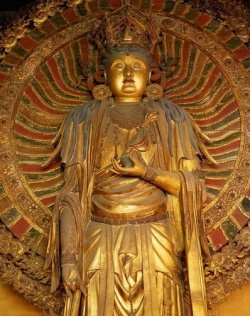An Introduction to Samantabadra
The image of Samantabhadra is one of the oldest & among the most complex Buddhism, because of its simplicity & because the figures bear no symbolic objects (accoutrements) which otherwise define the form. Yet most people realise that there is some profound underlying meaning
behind the form. The represents the realisation & flowering of pure consciousness. Owing to its simplicity, there are several Samantabhadra interpretations & meanings attached to the form.
The central concepts regarding the image 1. The original self which is perceived a pure awoken consciousness [Skt. bodhi). The Awoken self [viz. spiritual nature] which realises the delusion of the material world which is the common [
[[[perception]]]] of reality & in doing so is liberated. 1b.Understanding of the sun & moon, which themselves represent time {place} & the human condition respectively. 2a. The eternal Present moment which from the Awoken Mind of bodhi realizes the union of the past, present & future. 3. The origin of all form out of which all form is derived & within to which all form dissolves into Nothingness. The
nature of truth of reality, explored by the Buddhist Early Schools. These two leading schools are Sunyavada [aka. Madhyamaka) & Yogacara. The realisation of the this truth of reality generates the Bodhisattva the enlightened being of 'pure consciousness'. 4. According to Vajrayana Buddhism all Deities & Dakinis arose out of Samantabhadra. This idea is especially connected ot the Dhyana Buddha Familiies of Amitabha, Akshobhya, Amoghasiddhi, Ratnasambhava & Vairochana 5. Bodhissatva & figure of the Lotus Sutra [Skt. Avatamsaka Sutra) made the 10 vows to guide a bodhisattva.
Iconography
Samantabhadra also known as Visvabhadra, is naked called ‘sky clad’ (Skt. digambara, presented embracing figures the white female figure is called Samantabhadri in an body position [Skt. Asana) called Yab-Yum togetherness known as the body of blissful union called
Sambhogakaya. The word Samantabhadra means Universal loving Virtue. A union of the inner and outer world. The principle of duality is visualized in male & female, dark-light, love-hate, day & night. The co-emergence (Skt. Sahaja) of wisdom [Skt. Prajna) with
fitness of action [Skt. Upaya) which is similar to compassion leads one to a state of Great Bliss [Skt. Mahasukha]. The state of Great Bliss is akin to individual Nirvana. The eight embedded jewels represent the Eightfold Path realised by Sakyamuni. There is a small mirror Aina or Darpana representing introspection, sight or form together with a jewel offering in the foreground. The
two hand symbols [Tib. Ting Sha represent the sense offering of sound. The rainbow beams arising from the crimson nimbus around the head of Samanta Bhadra represent a mastery of Bodhi Nature & one manifestation of the Sambhogakaya is the Rainbow Body. There is a small mirror Skt. Aina or Darpana representing introspection, sight or form together with a jewel
offering in the foreground. The two hand symbols Tib. Ting-Sha represent the sense offering of sound. The rainbow beams arising from the crimson nimbus around the head of Samanta Bhadra represent a mastery of Bodhi Nature & one manifestation of
the Sambhogakaya is the Rainbow Body. The co-emergence [Skt. Sahaja] of wisdom [Skt. Prajna) withfitness of action [Skt. Upaya) which is similar to compassion leads one to a state of Great Bliss Skt. Mahasukha.
1. Commentary
1. The image of Samantabhadra represents a return to & understanding of our original self . This original self is perceived as a pure & blissful (happy). This position of understanding is perceived as pure awareness devoid of the delusion generated by greed thirst - Skt. tanha. & hatred Skt. Dhosa. Greed for instance makes us accumulate material wealth, an
emotional & physical dependence on material things. Hatred is perceived as jealousy, envy. These obscure our original nature & the real happiness. This causes suffering which is cyclical [Skt. Samsara) & self-perpetuating. The paradox here
is that the freedom of self is attained by having less & not more. By giving not taking, by relinquishing not gathering & so forth. The position of pure understanding is a position attained through deep thought & applied understanding. As we proceed we awaken to the pure consciousness [Skt. bodhi). The word Buddha is Sanskrit which means to be awake or to be awoken.
Take the example of a carefree, spontaneous & happy child compared to a stressed, tired & unhappy adult. But this state of pure consciousness does not mean we have to become children again. This is merely a good example of how change can not always be for the better. The Sambhogakaya state which
Samantabhadra is depicted is attained though understanding & by realising the delusion of the material world. The blissful union is one of transcendent understanding & liberated awareness rather than the spontaneous naivety of a child. B. 1b. The union of the
sun & moon, which themselves represent time {place} & the human condition respectively. It is beyond the common perception of the cyclical sun & moon that a person can enter the Dharmakaya & 4th Vajrakaya realms.
